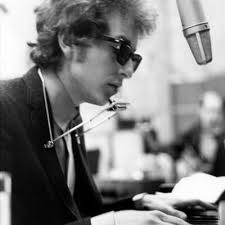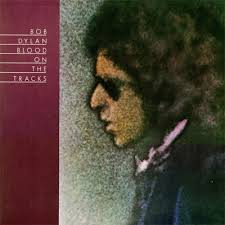Blood on the Tracks
| Bob DylanBlood on the Tracks
Blood on the Tracks is the 15th studio album by American singer-songwriter Bob Dylan, released on January 20, 1975[ by Columbia Records. The album marked Dylan's return to Columbia Records after a two-album stint with Asylum Records. Dylan commenced recording the album in New York City in September 1974. In December, shortly before Columbia was due to release the record, Dylan abruptly re-recorded much of the material in a studio in Minneapolis. The final album contains five tracks from New York and five from Minneapolis.-Wikipedia
Critic Reviews
Show All-
 Pitchfork
Pitchfork
2016= Bob Dylan’s moody 1975 epic is often referred to as his “breakup album,” but it might be his most welcoming LP, its music projecting an undeniable warmth.
-
 BBC
BBC
2007. It’s a world-weary, nostalgic and ultimately more poetic Dylan we hear, and that is what makes Blood… a timeless record.
-
 All Music
All Music
This is an album alternately bitter, sorrowful, regretful, and peaceful, easily the closest he ever came to wearing his emotions on his sleeve.
-
 Rolling Stone
Rolling Stone
1975. Blood on the Tracks will only sound like a great album for a while. Like most of Dylan, it is impermanent. But like the man who made it, the album answers to no one and was made for everyone. It is the work of someone who is not just seeing through himself, but looking through us — and still making us see things that we haven’t seen before.
-
 The Guardian
The Guardian
1975. This marks yet another change in his mood and style. It will delight all those who liked the early albums but were baffled by the subsequent development.
-
 Vinyl Reviews
Vinyl Reviews
Blood on the Tracks represented a return to form for Dylan and a reminder of his greatness.
-
 Pop Matters
Pop Matters
2002. Blood on the Tracks is the one album that rises above all other contenders, obscuring them in its titanic blaze, because it is, at once, so familiar as well as mysterious, and so seemingly simple and yet unruly.
-
 Best Classic Bands
Best Classic Bands
Whereas during Dylan’s folk-protest period he wrote lyrics that commented (if obliquely) upon social concerns, the collection of songs that make up Blood on the Tracks is decidedly inward-looking and personal.
-
 Odyssey
Odyssey
2016. It’s so emotionally driven while simultaneously showcasing Dylan’s masterful ability to craft music and lyrics. The simple melodies make it a memorable listen and places it up there in his discography next to the stellar "Blonde on Blonde and Highway 61 Revisited."
-
 Classic Rock Review
Classic Rock Review
2015. the album has collected ever-growing acclaimed in the four decades since its release, with many claiming it may be his finest overall release, if not his best produced.
-
 itunes Apple Music
itunes Apple Music
Dylan all but invented the concept of the modern singer/songwriter, but few of his early albums offer the genre’s signature intimacy. Blood on the Tracks—his honest and deeply personal eulogy for a failed relationship—changed all that.
-
 MoFi
MoFi
Dylan's masterpiece break-up album: sentimental redemption arises amidst sorrow, turmoil, sadness, and pain.
-
 Mark Prindle
Mark Prindle
it's the most melodic and traditionally musical album he's ever done, highlighted by extremely clear production, sparkling acoustic guitars, and Bobbaroo actually sounding excited by the project!
-
 The New Republic
The New Republic
1975. Dylan, his imagination and his voice are all in control again as they haven’t been so fully since “Blonde on Blonde” in 1966. And we can therefore expect “Blood on the Tracks” to flash the shape of the ‘70s as richly as his electric albums of the mid-‘60s voiced their own weird and wired days.
-
 The Absolute Sound
The Absolute Sound
2013. Bitterness but also resolution come through in Dylan’s voice as well as lyrics. The music ranges from the Blonde on Blonde-era organ balladry of “Idiot Wind” and the self-effacing blues of “Meet Me in the Morning” to the wordy “Lily, Rosemary and the Jack of Hearts” and the folksy finger-style guitar of “Buckets of Rain.”
-
 George Starostin's Reviews
George Starostin's Reviews
And yet, perhaps the best thing about the album is that, sincere or not, it does not simply wallow in depression and desperation, but takes a somewhat more stoic stance: "Life is sad / Life is a bust / All ya can do is do what you must".
-
 Getintothis
Getintothis
2015. Blood On The Tracks’ more personal approach helped give people a glimpse at the man behind the music and helped audience and critics alike, identify with one of the most important and enigmatic musical figures of the 20th century.
-
 Radio Silence
Radio Silence
2014. Blood on the Tracks is a masterpiece of torn-up love, the shreds of Dylan’s marriage.
-
 Aquarium Drunkard
Aquarium Drunkard
2015. Blood on the Tracks is not an album about a relationship (not Dylan’s, not anybody’s), but an album about the brokenness inherent, ultimately, in all relationships.
-
 Blog Critics
Blog Critics
2008 Blood On The Tracks is a personal journey of a life in turmoil and a relationship disintegrating. It is a look into the heart and mind of a man through the use of imagery, poetry and music.
-
 Music Times
Music Times
2015. Today, Jan. 20, marks the 40th anniversary of Bob Dylan's classic album Blood On The Tracks, a highly emotional and devastating set of songs which was seen by many as a stellar return to form for the iconic singer-songwriter, and is arguably his last truly great album.
-
 The Student Playlist
The Student Playlist
2015. Blood On The Tracks is simply one of those utterly singular yet universal records that seems to transcend its authorship, one that is at home in any record collection, like Kind Of Blue or In The Wee Small Hours. Even if a person doesn’t (or thinks they don’t) like Dylan, it’s his most communicable and emotionally available record.
-
 Silver's Blog
Silver's Blog
2013. It's a perfect record.



Rate This Album and Leave Your Comments